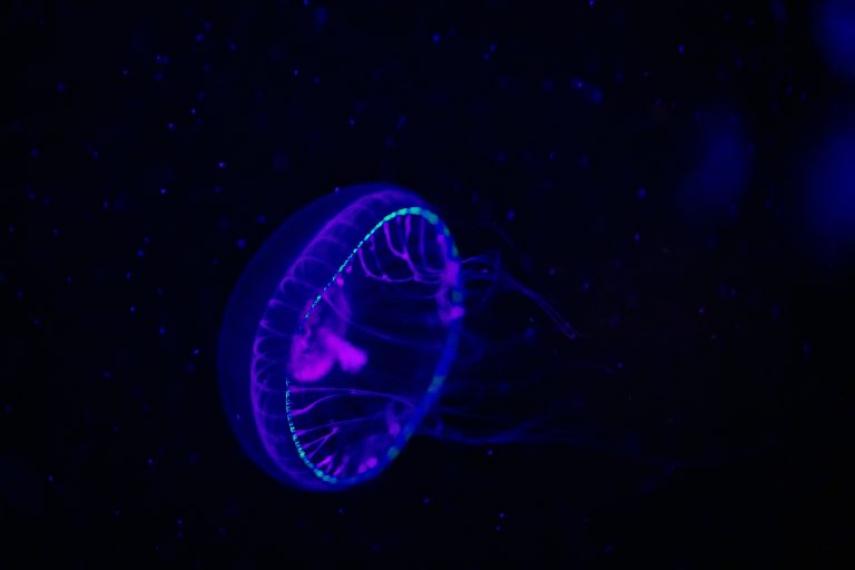Happy World Jellyfish Day! Jellies are an incredible group of marine animals that inhabit the open ocean, also known as the pelagic zone — the largest yet least understood habitat on earth! Jellies come in a variety of shapes, sizes, and colors — but they all lack a backbone since jellies are invertebrates! A favorite snack for several ocean predators — including sharks, sea turtles, and sunfish — jellies are important to countless marine ecosystems. This World Jellyfish Day, we’re highlighting a few of our resident jellies. You can spot all of these dazzling drifters in Hall of Fishes!
Crystal Jellies

Crystal Jellies light up the marine world as they drift through the open ocean. These jellies glow a green-blue color as they have over 100 tiny green fluorescent proteins responsible for lighting-up their bell! This illuminating finding was the basis for the Nobel Prize winning work of a team of scientists, including UC San Diego scientist Dr. Roger Y. Tsien. While other scientists first discovered the protein in jellies that glowed green under ultraviolet and blue light, Tsien and his collaborators tweaked and transformed these proteins so they glowed brighter and in different colors. This groundbreaking research forever lit up the scientific world as it meant scientists could assign a variety of colors to different proteins and cells. This is super useful to the biomedical field.
Besides their major contribution to the scientific community, Crystal Jellies are also extremely important to the open ocean ecosystem. These jellies are voracious predators — when feeding they can expand their mouth to swallow other jellies more than half their size! Crystal Jellies eat many different kinds of zooplankton and especially enjoy feeding on comb jellies.
Comb Jellies
All jellies are spectacular, however Comb Jellies set themselves apart thanks to the radiant rainbow effect that surrounds their body! But how do they produce this dazzling display? Comb Jellies are lined with 8 rows of cilia — which resemble the tiny teeth on a comb. The cilia refract light that hits the jelly and scatter it in different directions to create the appearance of a rainbow. Cilia also allow these jellies to push themselves through the water — they function like little oars to keep these jellies afloat.
Besides their rainbow-colored appearance, Comb Jellies have another unique feature. While many other jellies use stinging cells to capture prey, Comb Jellies have sticky tentacles that they use like a fishing line to catch unsuspecting prey. Like many other jellies, Comb Jellies typically use their tentacles to capture small crustaceans and plankton drifting by.
Egg Yolk Jellies
Is that a giant cracked egg floating underwater?! Chances are your breakfast didn’t get swept out to sea… you likely saw an Egg Yolk Jelly! These marine creatures are best known for their relatively large size and unique egg-like appearance. Egg Yolk Jellies are one of the largest species of jelly off the California coast — their giant cluster of over 100 tentacles can get upwards of 29 feet long — that’s about the length of 2 minivans!
Other kinds of jellies aren’t big fans of Egg Yolk Jellies. That’s because Egg Yolk Jellies love to snack on smaller jellies! Egg Yolk Jellies are equipped with 2 types of tentacles for more successful snacking. They have thin sensory tentacles that detect when prey is close by — then they use larger tentacles to sting and trap their prey.
Despite their predatory status, many marine creatures coexist with Egg Yolk Jellies! Small crabs and crustaceans are known to hitch a ride on the bells of Egg Yolk Jellies and some small fish even live among their tentacles!
Moon Jellies
If you ever find yourself in a sea of Moon Jellies no need to worry — stings from these jellies are completely harmless to humans. Moon Jellies form large groups — also called blooms, swarms, or smacks — close to the coast when there is lots of nutrients in the water. These blooms can attract Leatherback Sea Turtles and Ocean Sunfish — two animals that love to munch on Moon Jellies.
Moon Jellies get their name from their translucent appearance — but some of these jellies have made their way into orbit! 2,500 young Moon Jellies were passengers aboard the Columbia space shuttle in May 1991 as part of a study to determine the effects of weightlessness on their growth.
Interested in learning even MORE about jellies?! Be sure to listen to the San Diego News Fix podcast World Jellyfish Day episode! Aquarist Julie was invited to the podcast to talk about our dazzling resident jellies! Julie is our resident jellyfish expert here at the Birch Aquarium!